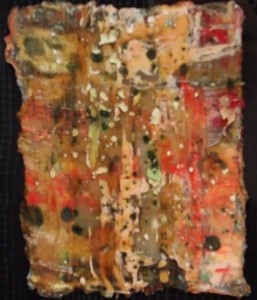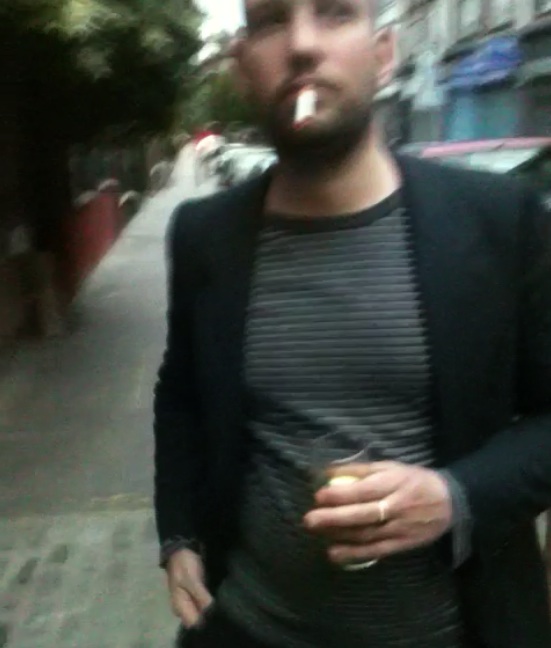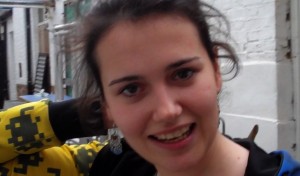Art vs. Money
In May, I attended the Persona Art Festival in London. It was organized by two young curators, Antria Pelekanou and Zia Fernandez, who assembled a challenging show of emerging artists from around the world–the UK, the United States, China, Germany, Slovakia, and many other countries. It was energizing to spend a few days with people passionately devoted to visual art, which ranged from film to performance art to painting, drawing and even a spooky, fascinating peephole diorama.
It was held in The Rag Factory, off Brick Lane, and on Saturday afternoon, a few of us headed a few doors down to The Pride of Spitalfields, one of London’s oldest continuously operating pubs—a real one, not an afterhours hangout for the financial district, a few blocks away. In attendance, standing on the brick pavement outside, a tall, patrician, adept 34-year-old conversationalist, Henry Whysall, kept squaring off against a 25-year-old Slovakian, Lenka Brazinova,
a largely self-taught painter just getting started, visiting from her home in Kosice. He wore a collarless, horizontally striped shirt and Lenka wore what looked like a sewn-together kindergarten puzzle: red sleeve, yellow sleeve, blue hood, along with a pair of bright red, old-school Adidas Gazelles. Her Slovakian accent, Russian-sounding, was heavy, but her English was quite good and she missed nothing in the conversation, her eyes bright and animated. A mentor once nicknamed her Little Black Puma. Rage Against the Machine is her favorite band. In the festival, her oil is a boldly Fauvist pair of nudes on a beach, a hedonistic glimpse of a pleasurable moment of idleness. Whysall’s work is an abstract grid of 67 small rectangles of handmade paper, lumpy and tactile, impregnated with wax and tainted with chemicals that imbue beautiful, otherworldly colors into the support—each small square of paper in its own frame, behind glass, like an artifact or collectible, full of colors that don’t seem possible to achieve with any other medium. They’re luminescent and magical and the work has a tactile presence that reminded me of Braque’s great mid-career paintings.
mid-career paintings.
“Money, no. It’s not the reason for painting, you can’t paint for money,” she said.
“I think the way art is valued and sold, and the way it’s produced now, perfectly reflects capitalist society. I’m not sure there’s anything wrong with art that reflects the system that supports it,” Whysall countered.
“But you do it for money, it’s worthless. You lose the meaning,” she snapped.
“Isn’t art supposed to represent the world you live in? Right? If that world is driven by money then the way art is produced can reflect that.”
There’s a bit of cat-and-mouse sophistry here, on Henry’s side, but he’s enjoying the way she won’t let up, and he’s loving her intensity.
“Do you like Mike Leigh?” I ask. “The early films?”
“Some. I’m ambivalent about him,” he says.
“Exactly. When it just seems you’ve turned on a camera and you’re recording the way the world is, is it art? The early Leigh, I mean. I’ve never been sure that kitchen sink realism is really art.”
“You’re saying art does more than just mirror the world. ”
“Yes. Jane Austen.”
“I love Jane Austen,” he says.
“She’s artificial. It’s contrived. It’s selective and isn’t socially realistic. But it conveys something true about human life.”
Lenka jumps back in, while someone goes inside for another round of pints.
“Art is spiritual. If it’s for money, it’s dead.”
“I’m just not sure that’s true,” Henry says.
It’s one of those fundamental questions with no easy answers. If art doesn’t sell, is it really reaching anyone? Dave Hickey would say no. But Van Gogh sold only one painting. Standing near the gate of someone’s driveway, next to the pub, Lenka tells me how she started making art. She found some colorful old crockery and smashed it to pieces, then started creating mosaics with the fragments. Her father warned her that art was no way to make a living, but she couldn’t resist. “I feel free only when I paint,” she told me. She went from the mosaics to painting, after spending time in France and taking lessons from a painter she met there—Jean Sobieski, father of Leelee Sobieski, the actress. She has only just begun exhibiting, and was so pleased to have gotten into the London show that she rode twenty hours, crossing Europe, to spend a week with her brother and friends, who live in the city.
In the few hours we spent together, Lenka reminded me that a genuine artist, full of hope and determination, would trek across Europe, simply to be a part of something she believed in. Any obstacles and disappointments I might face as an artist didn’t seem quite as daunting, having witnessed how this young woman guilelessly plunged into her role—only to make the return trip and find her life swallowed by the 10-hour shifts of her day job as a receptionist in Kosice.
“I need to move. I need to move to Prague,” Lenka says, sipping her beer. “I could live on a few hundred Euros a week in Prague, live and have a studio in the city. I have friends here, my brother, here in London, but it’s expensive. I love my country. I love my hometown. We have beautiful nature and history. But we don’t know how to use it and take care of it. Is worse and worse for poor and better for rich and people that steal and lie. Maybe I come to London. I have friends. I find place to live and work. But is expensive. London, these last few days, it really touch my heart.”
Last I heard, Lenka decided to quit her job and head back to France to paint for the summer. I’m eager to see whatever new new work she does. I’m also eager to see anything Mr. Whysall does, regardless of whether any money is changing hands in the process. Antria and Zia put on a tremendous festival–and they’re a couple of curators to watch in the years to come, independent, daring, a pair of charming entrepreneurs who have great insight offering Londoners a glimpse of some fine work they otherwise would likely never see.


Hello,
I had no idea this was online. It’s a very good article. You have captured the mood brilliantly! And thank you.
with warmest wishes. H
Thanks Henry. I loved the time I spent in London and talking with you and the others was a big part of the fun. Hope all is well there. Your work is great.
Hi guys,
I´d like to add few words to make my view on this more clear

I believe that all great artists when they are in the act of creation, their intention isn´t about „how much I will get for this“…i see it more like an act of loving, when you give something out of you, not expecting anything back, but naturally having exchange with the canvas, sculpture, video, whatever you as an artist makes. I also sell my art. Money rules the world and we need them for living, but more important for me as an artist is, how we make those money and how we make our art. Is our prime goal to make art or it is first of all about making money? The WAY is important. I just wanted to point out that art of today starts to be more about the industry, where all sublime intentions somehow vanish in the smog,,,,,
Hope you are both well
L.
Your English is getting great, Lenka. It’s so strange to hear from you now: I found the photograph I took of Henry in a box yesterday and put it on a little cabinet we have in our front hall. And here you are popping up again! I’d used that shot of Henry in a little informal show of photography I participated in here in Rochester and it came back in that box, but I’d lost track of it. I’m doing fine, Lenka. I’m just starting to zero in on a series of paintings I want to show in a solo exhibit at Viridian, in New York, next spring. It’s going to be a challenge getting all of it done, but I’m excited about the idea behind the show and am eager to get up in the morning and get to work. I don’t think any of us make enough from our work to even think of putting money over principles. But there really are complexities when you think about it: making choices about work that allows you to follow your heart without alienating most people. In other words making art that accessible to most people. I’ve always thought art ought to be addressed to everyone, not just an elite, and if that’s the case then selling could be a measure of how well you get through to ordinary folk. But I agree, the only way to make art is to focus on what moves you to paint. Write me an email and tell me what you’re up to! I’d love to post some of your latest work.
But there really are complexities when you think about it: making choices about work that allows you to follow your heart without alienating most people. In other words making art that accessible to most people. I’ve always thought art ought to be addressed to everyone, not just an elite, and if that’s the case then selling could be a measure of how well you get through to ordinary folk. But I agree, the only way to make art is to focus on what moves you to paint. Write me an email and tell me what you’re up to! I’d love to post some of your latest work.